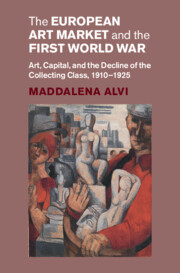 The European Art Market and the First World War
The European Art Market and the First World War Book contents
- The European Art Market and the First World War
- Studies in the Social and Cultural History of Modern Warfare
- The European Art Market and the First World War
- Copyright page
- Dedication
- Epigraph
- Contents
- Figures
- Acknowledgements
- Introduction
- 1 The European Market before 1914
- 2 The Great Conflagration (1914–1918)
- 3 ‘Wartime Cultural Changes’ (1914–1918)
- 4 Postwar Markets (1918–1925)
- 5 ‘The Challenges of New Markets’
- 6 Cementing Nationalisation (1918–1925)
- Conclusion
- Bibliography
- Index
Introduction
Published online by Cambridge University Press: 10 April 2025
- The European Art Market and the First World War
- Studies in the Social and Cultural History of Modern Warfare
- The European Art Market and the First World War
- Copyright page
- Dedication
- Epigraph
- Contents
- Figures
- Acknowledgements
- Introduction
- 1 The European Market before 1914
- 2 The Great Conflagration (1914–1918)
- 3 ‘Wartime Cultural Changes’ (1914–1918)
- 4 Postwar Markets (1918–1925)
- 5 ‘The Challenges of New Markets’
- 6 Cementing Nationalisation (1918–1925)
- Conclusion
- Bibliography
- Index
Summary
This study examines the role of art as a crucible of capital and property during the First World War and constructs a large-scale historical narrative of European auctions held between 1910 and 1925. By combining sources such as auction reports, newspaper articles, caricatures, individual memoirs, and financial and legal documents with an analysis of art prices, this study allows for making new observations about the evolution of European art markets, their disruption by the events of the First World War, and their transnational entanglements. Far from focusing solely on reconstructing the collecting patterns of prominent individuals or shedding light on specific histories of appropriation and looting, this book explores broader cultural and social developments across the British, French, and German art markets and their milieus and also touches upon trade spheres such as Italy, Switzerland, the Netherlands, Scandinavia, and Russia. While the First World War has often been neglected in scholarly studies as a phase of stagnation and stasis, this study shows that it had a disruptive impact on the art trade in the twentieth century and introduces a new transnational methodology for historical inquiries into cultural and artistic markets.
- Type
- Chapter
- Information
- The European Art Market and the First World WarArt, Capital, and the Decline of the Collecting Class, 1910–1925, pp. 1 - 10Publisher: Cambridge University PressPrint publication year: 2025
